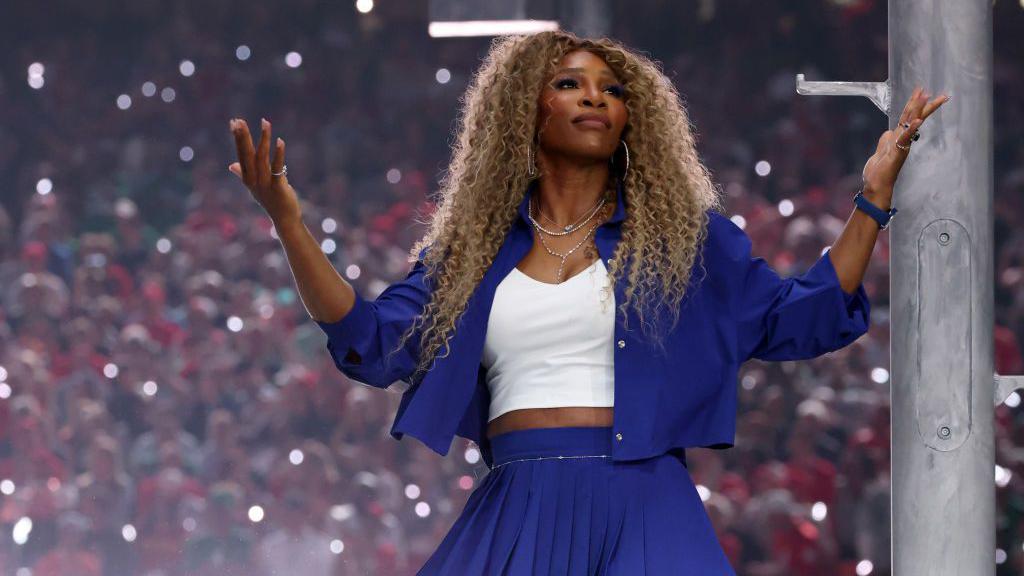Serena Williams Crip Walks ‘For the Culture’—Then Goes Home to THIS Guy! Fans Are STUNNED
When Serena Williams clinched her Olympic gold medal in tennis at the 2012 London Games, she didn’t just celebrate with the customary fist pump or leap into the air.
Instead, she broke into a brief but unmistakable dance—the crip walk—a move deeply rooted in West Coast hip hop culture.
For many, this was more than a victory dance; it was a powerful cultural statement, a celebration “for the culture.”
But as the world buzzed about her bold move, Serena Williams returned home to her private life, sharing her triumphs with her husband, Alexis Ohanian, and their family.
This moment, both on and off the court, encapsulates the multifaceted identity of one of the greatest athletes of all time.
Serena Williams: More Than an Athlete

Serena Williams is no stranger to making headlines, whether for her unparalleled achievements on the tennis court or her influence beyond sports.
With 23 Grand Slam singles titles, Williams is widely regarded as one of the greatest tennis players in history.
However, her impact extends far beyond athletic records.
Williams has become a symbol of empowerment, resilience, and cultural pride.
The 2012 Olympic Gold Medal Victory
The 2012 Summer Olympics in London marked a significant milestone in Serena Williams’ illustrious career.
After dominating the competition, Williams faced Maria Sharapova in the final, delivering a commanding performance that left no doubt about her superiority.
With a score of 6-0, 6-1, Williams secured her first Olympic singles gold medal—a crowning achievement that added to her already impressive legacy.
As the crowd erupted in applause, Williams’ spontaneous celebration caught the world’s attention.
She performed the crip walk, a dance move originating from the streets of Los Angeles, specifically associated with the Crips gang but later embraced as a symbol of West Coast hip hop culture.
For some, it was a controversial choice; for others, it was a powerful expression of identity and pride.
The Crip Walk: From the Streets to the World Stage

The crip walk, or “C-walk,” emerged in the 1970s as a dance associated with the Crips, one of Los Angeles’ most notorious street gangs.
Over the years, the dance evolved, shedding some of its gang-related connotations and becoming a staple in hip hop culture.
Artists like Snoop Dogg and Ice Cube have popularized the move, turning it into a celebration of West Coast heritage.
When Serena Williams performed the crip walk on the Olympic stage, she brought this piece of American culture to a global audience.
For many in the Black community and fans of hip hop, it was a moment of pride—a world-class athlete unapologetically embracing her roots.
Critics, however, questioned the appropriateness of the gesture, given its origins.
“For the Culture”: The Significance of Serena’s Dance
The phrase “for the culture” has become a rallying cry in recent years, signifying actions that uplift, represent, or celebrate Black culture and heritage.
Serena Williams’ crip walk was a quintessential example—an act of joy and cultural affirmation on one of the world’s biggest stages.
Williams later addressed the moment, explaining that she was simply caught up in the excitement and didn’t intend to make a political statement.
Yet, the impact was undeniable. For many, her dance was a reminder that Black athletes can celebrate their culture openly, even in spaces where they have historically been marginalized.
The Media Reaction: Praise and Controversy
The media response to Serena Williams’ crip walk was mixed. Some outlets praised her for bringing a piece of her culture to the Olympics, while others criticized the move as inappropriate.
The debate highlighted broader issues about representation, cultural expression, and the scrutiny faced by Black athletes.
In the days following the event, social media buzzed with discussions about the meaning of Williams’ dance.

Supporters argued that the crip walk had transcended its origins and become a symbol of resilience and cultural pride.
Critics, however, pointed to the dance’s association with gang violence, questioning whether it belonged on the Olympic stage.
Serena Williams and Alexis Ohanian: A Modern Love Story
After the excitement of the Olympics, Serena Williams returned home to her husband, Alexis Ohanian, co-founder of Reddit.
Their relationship, which began in 2015, has become a modern love story, celebrated for its mutual respect, support, and shared values.
Williams and Ohanian’s marriage represents a blending of worlds—sports and technology, African American and Armenian heritage, public life and private devotion.
Together, they have navigated the challenges of fame, parenthood, and activism, supporting each other’s endeavors both on and off the court.
Family Life: Balancing Stardom and Parenthood
In 2017, Serena Williams and Alexis Ohanian welcomed their daughter, Alexis Olympia Ohanian Jr. The couple has been open about the joys and challenges of parenthood, often sharing glimpses of their family life on social media.
For Williams, motherhood has been a transformative experience, inspiring her to advocate for women’s health and maternal rights.
Despite her demanding career, Williams has prioritized family, often traveling with her husband and daughter to tournaments around the world.
Ohanian, for his part, has championed paternity leave and gender equality, using his platform to support causes close to their hearts.
Serena’s Legacy: Redefining Success and Representation
Serena Williams’ legacy is defined not only by her athletic achievements but also by her willingness to challenge norms and break barriers.
Her crip walk at the Olympics was just one example of how she has used her platform to celebrate her culture and inspire others.
Williams has been a vocal advocate for diversity and inclusion in sports, speaking out against racism, sexism, and unfair treatment.
She has also launched ventures in fashion, business, and philanthropy, using her influence to empower the next generation.
The Importance of Cultural Expression in Sports

Serena Williams’ dance at the Olympics reignited conversations about the role of cultural expression in sports.
For many athletes, moments of victory are opportunities to pay homage to their roots, celebrate their communities, and assert their identities.
However, such expressions are often met with scrutiny, particularly for athletes of color.
Williams’ crip walk was a reminder that sports are not just about competition—they are also about storytelling, identity, and community.
By embracing her culture on the world stage, Williams paved the way for future athletes to do the same.
A Moment That Resonates
Serena Williams’ crip walk at the 2012 Olympics remains a defining moment in her career—a celebration “for the culture” that sparked global conversation.
As she returned home to her husband, Alexis Ohanian, and their family, Williams embodied the complexity and richness of her identity: a champion athlete, a proud Black woman, a devoted wife and mother, and a cultural icon.
Her story is a testament to the power of authenticity and the importance of representation.
Whether on the court, on the dance floor, or at home with her loved ones, Serena Williams continues to inspire millions around the world.
News
VIDEO: Police Release Heart-Wrenching 911 Audio Revealing Panic and Desperation During Marshawn Kneeland Incident — Girlfriend and Cowboys Players in a Frenzy to Save Him
VIDEO: Police Release Heart-Wrenching 911 Audio Revealing Panic and Desperation During Marshawn Kneeland Incident — Girlfriend and Cowboys Players in…
The loss of Cowboys defensive back Marshawn Kneeland has caused an explosive wave on social media: Heartbreaking final posts have been restored, shocking many.
The loss of Cowboys defensive back Marshawn Kneeland has caused an explosive wave on social media: Heartbreaking final posts have…
BREAKING: Marshawn Kneeland’s Tragic Demise. Police Reveal Shocking Details of Dallas Cowboys Star’s Final Moments
BREAKING: Marshawn Kneeland’s Tragic Demise. Police Reveal Shocking Details of Dallas Cowboys Star’s Final Moments In a heartbreaking turn of…
A Legacy Erased: The 2025 World Series Canceled Amid Unprecedented Corruption Scandal Involving Umpires and Dodgers Leadership
A Legacy Erased: The 2025 World Series Canceled Amid Unprecedented Corruption Scandal Involving Umpires and Dodgers Leadership In an astonishing…
Draymond Green’s Bold Criticism of Dak Prescott: An In-Depth Analysis of What Makes the Cowboys’ QB “A Bum”
Draymond Green’s Bold Criticism of Dak Prescott: An In-Depth Analysis of What Makes the Cowboys’ QB “A Bum” In the…
Jason Kelce just DROPPED THE HAMMER on the Dodgers with an unforgivable accusation. You won’t BELIEVE what he said about their “World Series.”
Jason Kelce just DROPPED THE HAMMER on the Dodgers with an unforgivable accusation. You won’t BELIEVE what he said about…
End of content
No more pages to load












